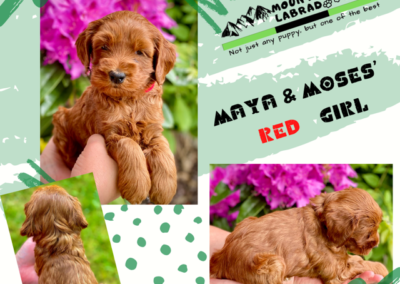Labradoodle Puppy Progress
Here’s how your puppy is growing and thriving

All of our Labradoodle puppies are whelped inside our puppy nursery. We have a whelping box set up that our mother dog gets used to several days in advance of her due date. I aid in whelping each individual puppy, keeping track of when their mom’s contractions start, pushing begins, and ultimately when the puppy is presented. As each puppy is born, he or she is weighed and tagged so that we can keep track of the health, growth, and identity. I check on the puppies every 2 to 3 hours, 24 hours a day, for a minimum of the first week, just to make sure they are healthy, nursing, and growing. Each puppy is held, weighed and snuggled several times a day to ensure they get used to my scent and the human touch.
The first 2 weeks of your puppy’s life are spent eating and sleeping. During this time they cannot see or hear, and they use their sense of smell and touch to find their mom’s nipples. In order to move around, they scoot and roll … and they do a good job and can scoot pretty fast! At this time, they are still at a very vulnerable stage and their mom continues to be attentive and protective. She will hardly even leave her puppies in order for me to serve meals to her and make sure her box is clean and comfortable. We continue to hold each puppy and begin clipping their nails to prevent the puppies from scratching up their mom’s tender tummy.


Your puppy’s eyes and ears open up between 2 and 3 weeks of age. This is still a time when they need a secure environment. Now they begin to get used to noises like the radio, vacuum cleaner and other household sounds.
As they begin to see the sights around them it’s important for them to have their mom nearby for reassurance. We hold the puppies up near our faces, so they can smell our breath and snuggle.
Next they go from scooting to walking, and by the time they are 4 weeks old, they can usually walk pretty well although they are still a little wobbly and very uncoordinated. Their sense of smell is still the strongest and most relied on sense that they use to identify us.
Once the puppies are 4 weeks old, I start feeding them “puppy mash,” which is softened, warmed, high-quality puppy food that is mashed. I add a little powdered goat’s milk to make it more desirable for them. By the time they are 5 weeks old, they are usually eating with lots of enjoyment; however, they’ll continue to nurse until they are 6 weeks old. I introduce them to a “piddle pad” or “litter box” at 4 weeks of age and it’s amazing to see how quickly they will start using it. By the time they are about 6 weeks old, they consistently go on a target. The advantage to a litter box over the piddle pad is that they will eventually learn to rip up the pad, even when it’s taped to the floor.


Also at 5 weeks, they move to our puppy-customized play pens. This is where they are introduced to the idea of a crate as their primordial “den” for a place they can count on to be safe, restful, and cozy! Just like their wolf ancestors, they love to get into the crate and bunch up together – sleeping on each other, mouthing, and kicking. The crate becomes a source of comfort for them and they get used to going in for naps and each night to sleep. When one puppy goes out to eat, drink, play, or meet mom, often all the others follow in the cutest little “train” of yawning, sleepy-eyed pups you’ve ever seen!
Eventually, the puppies are able to roam out into our large, fully secured spaces and “rub noses” with our adult Labradoodles that live with us while they show them the ropes. We continue their socialization by continuing to expose them to our family and team also with a variety of noises, such as lawn mowers, blowers and trucks, so they won’t be jumpy or nervous when they hear everyday living sounds and activities. The puppies are curious and adventurous, however they will normally follow us around as we are their pack leaders and give them a sense of security in this big, new world they are experiencing. Our puppies are exposed to a variety of surfaces like gravel, grass, bark, hardwood flooring and carpets.

Although the puppies become very used to all kinds of visitors coming and going – which is great for socialization – when you reserve your puppy, we think of him/her as being all yours and our priority is to ensure his or her safety, calm upbringing, and best care at all times until you pick up your pup. Please go to our Puppy Socialization page for more info.
To reserve your puppy today or check on a pup you’ve already reserved, email mtviewlabradoodles@gmail.com.
Here is an example of a puppy from week-1 to week-7: click the image to see the larger version and view all.







